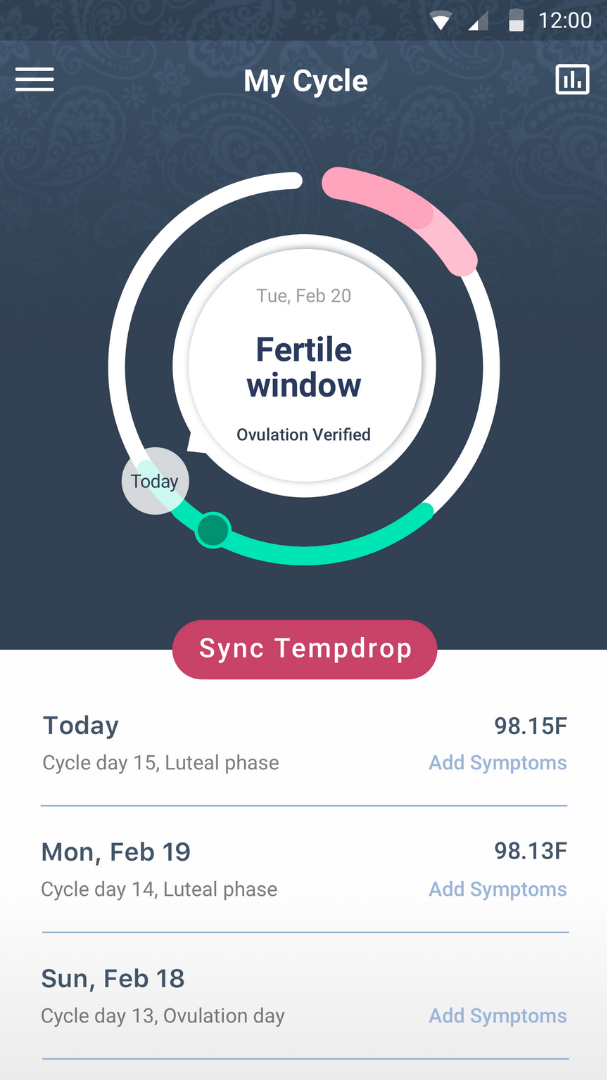Today we're bringing you something a little bit different - but every bit as useful! We asked Chloë Lubell, Certified Nurse Midwife, about postpartum charting and fertility, and we're going to share her answers with you now!
If I am exclusively breastfeeding, is this sufficient birth control?

When relying on breastfeeding for birth control, the studied method is called the Lactational Amenorrhea Method (LAM). Someone using LAM needs to follow the following rules in order to use it as an effective birth control method:
- They must be breast/chestfeeding exclusively, which means the baby’s mouth to nipple rather than pumping and bottle feeding pumped milk. Baby must be feeding every 4-6 hours throughout the day and night.
- They must have had no spotting or bleeding after their initial postpartum bleeding.
- Their baby must be 6 months or younger.
If the pair hits all three of those markers, they have a 98.5% efficacy rate at preventing pregnancy, which means 1-2 people out of 100 will become pregnant within a year of use.
This has the same efficacy rate as birth control pills, but less effective than some other methods like IUDs or implants. This means that the question of sufficient birth control is a question for you - does that feel like sufficient birth control to you? Do you want 99.95% efficacy? If so, you might consider something more than LAM.
Choosing a birth control method always means weighing priorities, risks, and benefits. If your main concern is avoiding pregnancy, look to Long Acting Reversible Contraceptives like IUDs and the Implant. If your main concern is avoiding hormones, look to LAM, the Paragard IUD, condoms, and the diaphragm. It’s always smart to combine LAM with a fertility awareness method to get a clearer picture of your hormonal cycle.
Should I use Lactational Amenorrhea Method or Ecological Breastfeeding?

The difference between Lactational Amenorrhea Method (LAM) and ecological breastfeeding (EBF) is one of lifestyle. LAM requires no period, baby’s mouth to nipple every 4-6 hours, and a baby younger than 6 months. EBF requires cosleeping, no pacifiers, no pumping, mouth-to-nipple only, and almost no separation of birth parent and baby. There is no research supporting EBF, though that’s simply because the research hasn’t been done yet.
The hope is that using EBF can delay ovulation for up to 14-15 months after birth, unlike the 6 that are promised with LAM.
If you want to use nursing to prevent ovulation and therefore prevent pregnancy, it’s again a question of your priorities. Does that lifestyle seem doable for you? Do you have the support you need to make that work? Are you able to stay with your baby almost all day, almost every day for the first 14-15 months of their life? Many people can make that work and love living that way, while others want or need to have more separation from their baby due to working outside the home.
When should I start charting again postpartum?
Start charting when you have enough brain space to think about it, though it’s better to have a few months of data before you need to use it either for preventing or encouraging pregnancy One’s cycle can change significantly after birth, leading to many surprises when people rely on what they knew of their pre-pregnancy cycle. It's also important to choose an appropriate method to use postpartum, as not all methods have postpartum protocols, so will be more difficult to use during this period. Three cycles is a good minimum to get to know one’s body again before relying on that to avoid pregnancy or spending lots of money, time, and energy trying to become pregnant.

What should I expect my charts to look like postpartum?
Since there is a delay between birth and the return of ovulation, your chart will look like one long pre-ovulation (follicular) phase. You’ll notice lower temps and no prolonged temperature shift. If you’re monitoring your temperature consistently after birth it’s likely you will catch your first ovulation, before you get your period.
When you start ovulating again, you may find that your body falls directly back into the patterns it had before pregnancy, though for some people things change entirely. Give yourself time to re-learn your body and your cycle patterns.
What signs should I be looking out for that ovulation is/has returned postpartum?
One good sign that you’re beginning to cycle again is period-type bleeding. You might also find that you start to see the other signs of ovulation: egg white cervical fluid, change in cervical position, consistency, openness, ovulation sensation, and anything else you know that your body does throughout the cycle. If you’re checking your temps with Tempdrop, you’ll begin to notice temperature shifts that correspond to the other symptoms you’re noticing.
How soon should I expect to see a return to fertility?
This is different for everyone! Every individual body has its own rules and follows its own rhythm. On average, most people do not ovulate for the first six months postpartum if they are body feeding exclusively. Some people will begin ovulation sooner and some later, no matter their feeding status or pattern.
Do you have any other questions about postpartum cycles or charting? Ask them on our Instagram!

Chloë Lubell is a Certified Nurse Midwife in Brooklyn, NY. She offers homebirth care throughout pregnancy, birth, and the postpartum period, as well as fertility work, at-home IUI, GYN care, and gender affirming hormone therapy. After graduating from Yale School of Nursing with a Masters in Midwifery in 2014, Chloë practiced at Bellevue Hospital and Central Park Midwifery at Mount Sinai West Hospital before beginning her own homebirth practice, Cosmos Midwifery. Chloë gave birth to her daughter on the fiftieth anniversary of the moon landing at home underwater in the presence of her husband, mother, midwife, doula, and dog.

